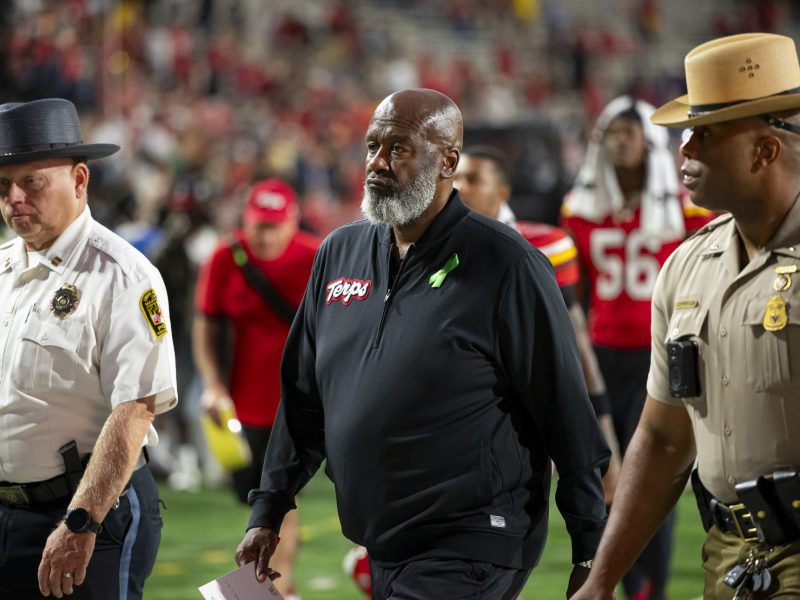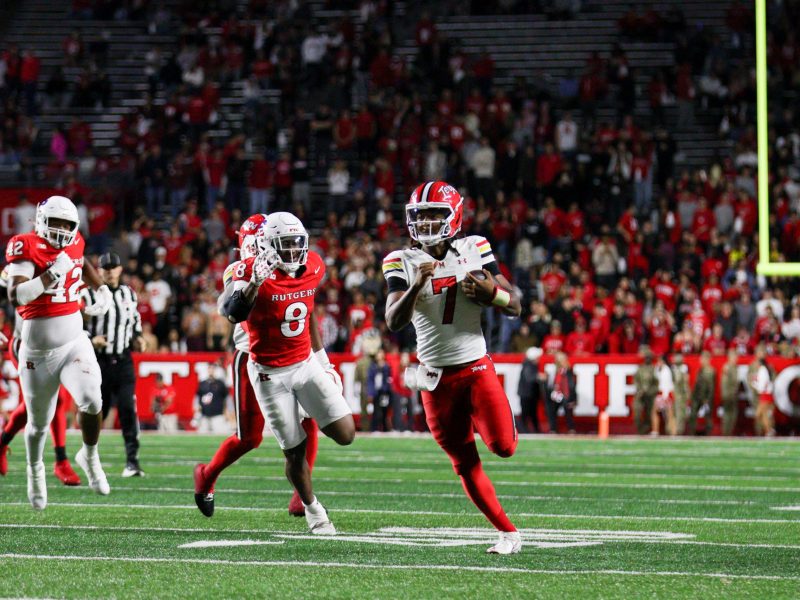By Jake Kauderer and Michael Howes
With Maryland football on its second bye this week, The Diamondback’s football beat writers Jake Kauderer and Michael Howes asked readers to submit questions for a Terps mailbag.
We selected a few to answer.
Is it fair to say coach Michael Locksley’s job security is waning? He received the benefit of the doubt for years, but another disappointing start to Big Ten play seems to have more people ready to move on. Any sense if that’s legitimate noise or just fan chatter?
Mike: The criticism surrounding Locksley is fair — at this point, it’s reasonable to assume a Power Four coach in his position would be on the hot seat. The seventh-year Maryland coach is 15-34 after September, compared with 21-5 earlier in the season, with most wins coming against weak nonconference opponents.
And this year, college football has seen coaches dismissed despite accomplishing far more. Take Penn State’s James Franklin, who was fired on Oct. 12 after guiding the Nittany Lions to the College Football Playoff semifinals in January.
Or look at Florida’s Billy Napier, who was fired earlier this season despite posting a nearly identical conference win rate to Locksley’s — less than half — albeit at a program with far higher expectations.
[Here are 3 takeaways from Maryland football’s heart-wrenching loss at UCLA]
Still, it’s fair to argue that Locksley remains the right person for the job. Several high-profile programs coaching jobs are expected to open this offseason that the Terps would have to compete against.
Despite his struggles in conference play, Locksley has continued to attract top talent through strong recruitment, built a young core that already contributes and will welcome Zion Elee, the state’s top 2026 prospect, as an early enrollee this spring.
For new athletic director Jim Smith, this is his first major decision. My take is to give Locksley one more year, then reevaluate.
Do you think the number of schools with a more appealing opening than Maryland could impact it wanting to look for a coach this year? Who could the Terps target if they choose to search?
Jake: While recent coaching openings at typically strong football programs matter, I don’t feel it has a bearing on Maryland. If the Terps’ job became available, I would expect strong interest.
Malik Washington is among the nation’s promising young quarterbacks. The defense features a plethora of young talent, especially on the defensive line. Smith has already conveyed improving the program is a priority.
And Maryland fans are desperate for a team to rally behind.
Take Indiana, which went just 3-9 and 1-8 in the Big Ten during the 2023 season before hiring coach Curt Cignetti. The Hoosiers made the College Football Playoff in his first season, and are now the No. 2 team in the country. With the resources Big Ten schools have, there’s reason to believe Maryland’s job would be highly sought — even amid the program’s issues.
Franklin is a fascinating option after going 104-45 with Penn State before being fired, largely due to the inability to win big games.
[Maryland football collapses in third consecutive game and falls to UCLA, 20-17]
He was in line to become the Terps’ coach after serving as offensive coordinator and quarterbacks coach from 2008 to 2010. The hire never came to fruition when Maryland hired a new athletic director.
But a reunion could make sense. Franklin is known for revitalizing struggling programs and his genuine relationships with players. With his strong recruiting ability, he seems like a real candidate if the Terps’ job opened.
Does Malik Washington have a chance at winning a freshman award?
Mike: Through Maryland’s first four games — including a win at Wisconsin — I would’ve called Washington a leading contender for the Big Ten Thompson–Randle El Freshman of the Year.
The Terps have dropped three straight since then, and Washington just endured his worst performance of the season. He’s still in the mix, but has work to do.
Washington has attempted more passes than any quarterback in the conference, yet ranks eighth in yards and seventh in touchdowns. Both numbers sit ahead of Michigan’s freshman quarterback Bryce Underwood — and while the Wolverines have faced their own struggles, they’re 5-2 and ranked No. 25. Winning matters.
There’s also Ohio State running back Bo Jackson, who ranks 10th in the Big Ten in rushing and plays for the nation’s top-ranked team.
With no runaway favorite like last year’s Jeremiah Smith, this year’s race could open up for a defender. Maryland’s Sidney Stewart and Zahir Mathis are both candidates.
What is a position group people should be on the lookout for the remainder of the season?
Jake: Maryland’s receivers thrived early but have struggled in Big Ten play, with running back DeJuan Williams hauling in the most receiving yards against UCLA.
Senior Shaleak Knotts hasn’t scored after finding the endzone five times in the first four games. Senior Octavian Smith Jr. went over 100 yards twice in the first four games and hasn’t topped 60 since. Oklahoma transfer Jalil Farooq was expected to be a dynamic playmaker, but leads the team with six drops and is primarily used around the line of scrimmage.
With the Terps last in the Big Ten in rushing yards, pressure heightens on the receivers to create big plays.
Considering the group is largely unproven — Knotts recorded just 241 receiving yards across three years before 2025 and Farooq is coming off a broken foot — there’s questions on how much pressure the unit can alleviate from Washington in conference play.
What stands out from a positive and negative perspective in Big Ten play so far?
Jake: The Terps’ defense keeps forcing turnovers.
Maryland leads the nation with a +11 turnover margin, 14 interceptions and ranks atop the Big Ten with four defensive touchdowns — including one each of the past two weeks.
New additions lead the resurgence. Transfer cornerbacks Jamare Glasker and Dontay Joyner have pick-sixes the past two weeks. Stewart forced a fourth-quarter fumble against the Bruins and leads the team with more than five sacks.
While the Terps’ defense has left much to be desired in finishing games, its ability to support a young offense with game-altering plays is impressive. Maryland’s success could largely depend on the unit’s ball-hawking ability, especially with three ranked games looming.
Mike: Maryland’s ground game continues to struggle.
The Terps have the fewest rushing yards in the Big Ten and average 3.5 yards an attempt, second-worst in the conference. The lack of rushing can be blamed for Washington’s high passing rates, which can lead one to question whether it hindered the freshman’s development.
It seemed Maryland corrected its failures against Nebraska — averaging 4.3 yards a carry. But the next week against the Bruins, the Terps’ running backs averaged less than three yards an attempt with Washington ending as the team’s leading rusher. Not a good sign.
If Maryland wants to ease stress off Washington’s arm going forward, it’ll need to establish the running backs as legitimate threats. That’s been far from the case so far.



